Wanda Gág
Wanda Hazel Gág /ˈɡɑːɡ/ (March 11, 1893 – June 27, 1946) was an American artist, author, translator, and illustrator. She is best known for writing and illustrating the children's book Millions of Cats, the oldest American picture book still in print.[1] Gág was also a noted print-maker, receiving international recognition and awards.[2] Growing Pains, excerpts from the diaries of her teen and young adult years, received widespread critical acclaim.[3] Two of her books were awarded Newbery Honors and two of them received Caldecott Honors.
Wanda Hazel Gág | |
|---|---|
 Gág in December 1916 | |
| Born | March 11, 1893 New Ulm, Minnesota, United States |
| Died | June 27, 1946 (aged 53) New York, New York |
| Occupation | Artist, writer, translator |
| Nationality | American |
| Genre | Children's literature |
| Notable works | Millions of Cats |
| Notable awards | Newbery Honor, Caldecott Honor |
Early years
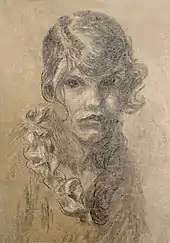
Born March 11, 1893, in the German-speaking community of New Ulm, Minnesota,[4][5] to Elisabeth Biebl Gag and the artist and photographer Anton Gag. Wanda, the eldest of the seven Gag children, was 15 when her father died of tuberculosis.[6] His final words to her were: "Was der Papa nicht thun konnt', muss die Wanda halt fertig machen." (What Papa couldn't do, Wanda will have to finish.)[7] Following Anton's death the Gag family was on welfare and some townspeople thought that Wanda should quit high school and get a steady job to help support her family. Despite this pressure, Wanda continued with her high school education. While still a teenager her illustrated story Robby Bobby in Mother Goose Land was published in The Minneapolis Journal in their Junior Journal supplement.[8] After graduating in June, 1912 she taught country school in Springfield, Minnesota, from November 1912 to June 1913.[9]
Art school
In 1913 Gág began a platonic relationship with University of Minnesota medical student Edgar T. Herrmann who exposed her to new ideas in art, politics and philosophy.[10] With a scholarship (and the aid of friends), she attended The Saint Paul School of Art in 1913 and 1914.[11] From 1914 to 1917 she attended The Minneapolis School of Art under the patronage of Herschel V. Jones.[12][13] While there, she became friends with Harry Gottlieb and Adolf Dehn.[14] In 1917 she completed her first illustrated book commission (as Wanda Gäg) A Child’s Book of Folk-Lore— Mechanics of Written English by Jean Sherwood Rankin.[15]
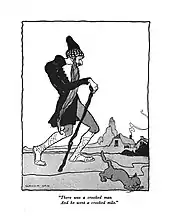
New York
In 1917 Gág won a scholarship to the Art Students League of New York where she took classes in composition, etching and advertising illustration.[16] By 1919 Gág was earning her living as a commercial illustrator.[17] In 1921 she became a partner in a business venture called Happiwork Story Boxes; boxes decorated with story panels on its sides.[18] An illustration of Gág's was published in Broom: An International Magazine of the Arts in 1921.[19][20] Gág's art exhibition in the New York Public Library in 1923 was her first solo show. She began signing her name "Gág" around this time.[21]
In 1924 Gág's work was published in a short-lived folio-style magazine with artist William Gropper.[22] In 1925 she created a series of illustrated crossword puzzles for children that was syndicated in several newspapers.[23] Gág's one-woman-show in the Weyhe Gallery in 1926 led to her being acclaimed as "… one of America’s most promising young graphic artists… " and was the start of a lifelong relationship with its manager, Carl Zigrosser.[24][25] Gág began to sell numerous lithographs, linoleum block prints, water colors and drawings through the gallery.
In 1927 her article These Modern Women: A Hotbed of Feminists was published in The Nation, drawing the attention of Alfred Stieglitz and prompting the publisher and designer Egmont Arens to write: "The way you solved that problem (her relationship with men) seems to me to be the most illuminating part of your career. You have done what all the other ‘modern women’ are still talking about."[26][27][28] Gág’s illustrations were published on the covers of the leftist magazines The New Masses and The Liberator.[29][30]
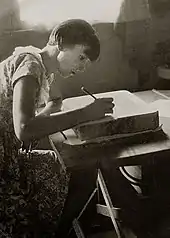
In 1928 Gág hand-colored some of Rockwell Kent's illustrations in a limited edition of Candide.[31] In a 1929 New York Times review, Elisabeth Luther Cary described Gág's print Stone Crusher: "Pure imagination leaps out from dusky shadows and terrifies with light, an emotional source difficult to analyze."[32] Her work was recognized internationally and was selected for inclusion in the American Institute of Graphic Arts Fifty Prints of the Year in 1928, 1929, 1931, 1932, 1936, 1937 and 1938.[33] Gág's work was shown at The Museum of Modern Art 1939 exhibition Art in Our Time and the 1939 New York World's Fair American Art Today show.[34]
In 2020, during the COVID-19 pandemic that prompted the temporary closure of many U.S. museums, the Philadelphia Museum of Art featured Gág in an online exhibit which featured works that she drew on sandpaper in rural New Jersey during the 1920s and '30s.[5] She used the sparkly and gritty quality of the sandpaper to emphasize rustic qualities in her subjects.[35]
Works for children
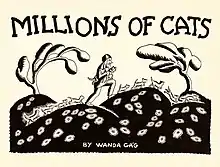
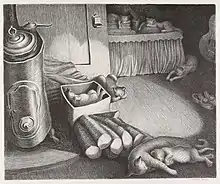
In 1927 Gág's illustrated story Bunny's Easter Egg was published in John Martin's Book magazine for children.[36] Gág's work caught the attention of Ernestine Evans, director of Coward-McCann's children's book division. Evans was delighted to learn that Gág had children's stories and illustrations in her folio and asked her to submit her own story with illustrations. The result, Millions of Cats, had been developed from a story that Gág had written to entertain the children of friends. It was published in 1928.[37] Anne Carol Moore (in the New York Herald Tribune) wrote: "… It bears all the hallmarks of becoming a perennial favorite among children, and it takes a place of its own, both for the originality and strength of its pictures and the living folk-tale quality of its text. A book of universal interest to children living anywhere in the world."[38] Millions of Cats is on the New York Public Library's list of 100 Great Children's Books.[39]
In 1935 Gág published the "proto-feminist" Gone is Gone; or, the Story of a Man Who Wanted to Do Housework.[40]
To encourage the reading of fairy-tales, Gág translated and illustrated Tales from Grimm in 1936. English critic Humbert Wolfe, commenting on Gág's translation, wrote: "From the very first page it was clear that Miss Gág was chopping away a perfect brushwood of clumsy phraseology to let in the light."[41] Two years later she translated and illustrated the Grimm story Snow White and the Seven Dwarfs in reaction to the "trivialized, sterilized, and sentimentalized" Disney movie version.[42] Her essay "I Like Fairy Tales" was published in the March 1939 issue of The Horn Book Magazine. More Tales from Grimm was published posthumously in 1947. Four of her translated fairy tales were later released with illustrations by Margot Tomes.
Personal life
Gág liked to live and work in the country. In the early 1920s she spent summers drawing at various locations in rural New York and Connecticut.[18] She rented a three-acre farm ("Tumble Timbers") in Glen Gardner, New Jersey from 1925 to 1930 and later purchased a larger farm (“All Creation”) in Milford, New Jersey in 1931.[43]
She continued to support her unmarried adult siblings, some of whom lived with her from time to time. Gág's brother Howard did the hand lettering for most of her picture books and she also encouraged her sister Flavia to create illustrated books for children.[44]
In addition to Earle Humphreys (her long-time paramour and business manager) Gág had other lovers including: Adolph Dehn, Lewis Gannett, Carl Zigrosser, and Dr. Hugh Darby. She married Humphreys on August 27, 1943.[45]
Gág died from lung cancer in New York City, June 27, 1946.[46]
Legacy
Gág is widely considered to be a pioneer in the development of the picture book form. Prior to Millions of Cats, illustrated books generally had text on the left page with pictures on the right. Gag integrated the text with the pictures, often stretched across a double page.[47]
Influence
Some of the artists inspired by Wanda Gág are Eric Rohmann,[48] Ursula Dubosarsky,[49] Susan Marie Swanson,[50] Jan Brett, Maurice Sendak,[51] and Ray Johnson.[52]
Memorials
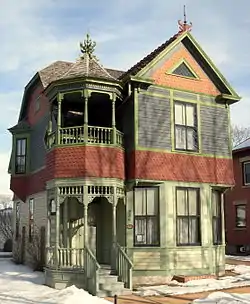
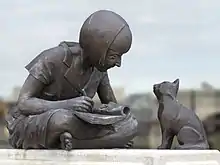
Gág was honored by The Horn Book Magazine in a tribute issue in 1947.[53] Her childhood home in New Ulm, Minnesota has been restored and is now the Wanda Gág House, a museum and interpretive center that offers tours and educational programs.[54] In 1992 Millions of Cats was featured on the television series Shelley Duvall's Bedtime Stories, narrated by James Earl Jones.[55] A bronze sculpture of Gág (with one of her cats) by Jason Jaspersen was erected at the public library of New Ulm, Minnesota in 2016.[56] In 2017 The Sandbox Theatre in Minneapolis produced In The Treetops, a new play that focused on Gág's childhood years.[57]
Awards
The books Millions of Cats and The ABC Bunny were recipients of a Newbery Honor.[58] Both Snow White and the Seven Dwarfs and Nothing at All received a Caldecott Honor. Wanda was posthumously honored with The Lewis Carroll Shelf Award in 1958 and The Kerlan Award in 1977. The Wanda Gág Read Aloud Book Award is awarded each year by the University of Minnesota, Moorhead. In 2018, Gág was posthumously honored with The Museum of Illustration at the Society of Illustrators Original Art Lifetime Achievement Award.[59]
Archives
Gág's prints, drawings, and watercolors are in the collections of The National Gallery of Art,[60] the British Museum,[61] The Minneapolis Institute of Arts,[62] The Whitney Museum[63] and other museums around the world. Gág's papers, manuscripts and matrices are held in the Kerlan Collection[64] at the University of Minnesota, The New York Public Library, The University of Pennsylvania,[65] The Free Library of Philadelphia and the Minneapolis Institute of Art.[66]
Works
Books
Writer and illustrator:
- Batiking at Home: a Handbook for Beginners, Coward McCann, 1926
- Millions of Cats, Coward McCann, 1928
- The Funny Thing, Coward McCann, 1929
- Snippy and Snappy, Coward McCann, 1931
- Wanda Gág’s Storybook (includes Millions of Cats, The Funny Thing, Snippy and Snappy), Coward McCann, 1932
- The ABC Bunny, Coward McCann, 1933
- Gone is Gone; or, the Story of a Man Who Wanted to Do Housework, Coward McCann, 1935
- Growing Pains: Diaries and Drawings for the Years 1908-1917, Coward McCann, 1940
- Nothing At All, Coward McCann, 1941
Translator and illustrator:
- Tales from Grimm, Coward McCann, 1936
- Snow White and the Seven Dwarfs, Coward McCann, 1938
- Three Gay Tales from Grimm, Coward McCann, 1943
- More Tales from Grimm, Coward McCann, 1947
Illustrator only:
- A Child’s Book of Folk-Lore— Mechanics of Written English, by Jean Sherwood Rankin, Augsburg, 1917
- The Oak by the Waters of Rowan, by Spencer Kellogg Jr, Aries Press, New York, 1927
- The Day of Doom, by Michael Wigglesworth, Spiral Press, 1929
- Pond Image and Other Poems, by Johan Egilsrud, Lund Press, Minneapolis, 1943
Translator only:
- The Six Swans, illustrations by Margot Tomes, Coward, McCann & Geoghegan, 1974
- Wanda Gág's Jorinda and Joringel, illustrations by Margot Tomes, Putnam, 1978
- Wanda Gag's the Sorcerer's Apprentice illustrations by Margot Tomes, Putnam, 1979
- Wanda Gag's The Earth Gnome, illustrations by Margot Tomes, Putnam, 1985
Other:
- The Sweet Porridge, by Wanda Gag [et al.], pictures by Jill McDonald [et al.], Methuen Educational, 1966
Selected prints
|
|
|
References
- Gregory, Alice. "Juicy As a Pear: Wanda Gág's Delectable Books". The New Yorker, April 24, 2014.
- Audur H. Winnan. Wanda Gág. Washington, DC: Smithsonian Institution Press, 1993, pp. 72-76.
- Hoyle, Karen Nelson. Introduction in Growing Pains: Diaries and Drawings for the Years 1908-1917. Saint Paul, Minnesota Historical Society Press, 1984, p. xviii.
- Wanda Gág: Illustrator & Author: Overview. Minnesota Historical Society. Accessed April 26, 2011.
- "Philadelphia Museum of Art - Artist in Focus: Wanda Gág". philamuseum.org. Retrieved 2020-05-25.
- Winnan, p. 2.
- Gág, p. xxxi.
- Richard W. Cox, Minnesota History, Fall 1974, p. 250.
- Winnan, p. 89.
- Winnan, p.5
- Winnan, p.2
- Gág, p. 314
- Winnan, p.4
- Wanda Gág Papers, 1892-1968
- https://catalog.hathitrust.org/Record/006536867
- Gág, pp. 459,466
- Hoyle, Karen Nelson, Wanda Gág, a Life of Art and Stories pp. 8-10, University of Minnesota Press, 2009
- Hoyle, pp. 10-13
- Loeb, Harold, Broom, 1921, vol. II, no. 2
- http://bluemountain.princeton.edu/contributions.html?titleURN=bmtnaap&authid=http://viaf.org/viaf/14845492
- Winnan, p. 13
- Winnan, p. 15
- Winnan, p. 239
- L’Enfant, Julie, The Gág Family, Afton Historical Society Press, 2002, p.123
- The New Yorker: November 13, 1926, p. 90
- Winnan, p. 36, 71
- L'Enfant, p.130
- https://archive.org/details/nation124jannewy/page/n717/mode/2up
- Hemingway, Andrew, Artists on the Left: American Artists and the Communist Movement 1926-1956, 2002
- Exhibition at Tweed Museum of Art, University of Minnesota-Duluth, 2008-9
- Candide, Voltaire and Kent, Random House: New York, 1928
- New York Times, December 15, 1929.
- Winnan, pp. 72-76.
- L'Enfant, p. 156.
- "Rain", c. 1926, drawing on sandpaper by Wanda Gág, Philadelphia Museum of Art, collection number 1968-24-178.
- John Martin's House: New York, vol. XXXV, issue no. 4
- Winnan, p. 36
- Millions of Cats dust jacket, second edition, 1928
- http://www.nypl.org/childrens100
- Popova, Maria, The Story of a Man Who Wanted to do Housework: A Proto-Feminist Children's Book from 1935. Brain Pickings site.
- Wolfe, Humbert, "Golden Lads and Lasses". The Observer, December 5, 1937.
- Silvey, Anita. The Essential Guide to Children’s Books and Their Creators. Houghton Mifflin, 2002, p. 171.
- Winnan, pp. 71-73
- New Ulm Journal, July 29, 2010.
- Winnan, p. 44, 55, 61
- L'Enfant, p.165
- http://www.prattlibrary.org/research/tools/index.aspx?cat=19949&id=4554
- Seven Impossible Things Before Breakfast » Blog Archive » Seven Impossible Interviews Before Breakfast #65: Author/Illustrator Eric Rohmann
- Ursula Dubosarsky Archived 2013-04-28 at the Wayback Machine
- The House in the Night board book ISBN 0547577699
- Wanda Gág's 'Millions of Cats' — An American Classic for Children | One-Minute Book Reviews
- Robert Pincus-Witten, Artforum, February 2015
- The Horn Book Magazine, issue 23, May–June 1947
- Wanda Gág House, accessed June 2012
- https://www.imdb.com/title/tt1254610/
- New Ulm Journal, November 26, 2016.
- https://www.sandboxtheatreonline.com/in-the-treetops-2017/
- Nelson., Hoyle, Karen (2009). Wanda Gág : a life of art and stories (1st University of Minnesota Press ed.). Minneapolis: University of Minnesota Press. ISBN 9780816667710. OCLC 319248395.
- New Ulm Journal, Nov 14, 2018
- Research Collection
- Research Collection
- Minneapolis Institute of Arts
- Collection Index
- Chevalier, Tracy (ed.). Twentieth-Century Children's Writers. Chicago: St. James Press, 1989, p. 370.
Further reading
| Library resources about Wanda Gág |
| By Wanda Gág |
|---|
- Cox, Richard W., The Bite of the Picture Book, pp. 238–254, Minnesota History Magazine, Fall, 1975[1]
- Gág, Wanda, Growing Pains, Borealis/Minnesota Historical Society Press, Saint Paul, 1984
- Hoyle, Karen, Wanda Gág, Twayne Publishers, 1994
- Winnan, Audur, Wanda Gág: A Catalogue Raisonne of the Prints , Smithsonian Institution Press, 1993
External links
| Wikimedia Commons has media related to Wanda Gág. |
- Works by Wanda Gág at Faded Page (Canada)
- Wanda Gág in MNopedia, the Minnesota Encyclopedia
- , National Gallery of Art
- Wanda Gág - Rights and Restrictions Information (Prints and Photographs Reading Room, Library of Congress)
- Wanda Gág House
- Collection summary to the Wanda Gág Papers at the University of Minnesota Libraries Children's Literature Research Collections
- Finding aid to the Wanda Gág papers at the University of Pennsylvania Libraries
- Finding aid to the Wanda Gág papers at Penn State University's Special Collections Library
- Wanda Gág at Library of Congress Authorities, with 52 catalog records